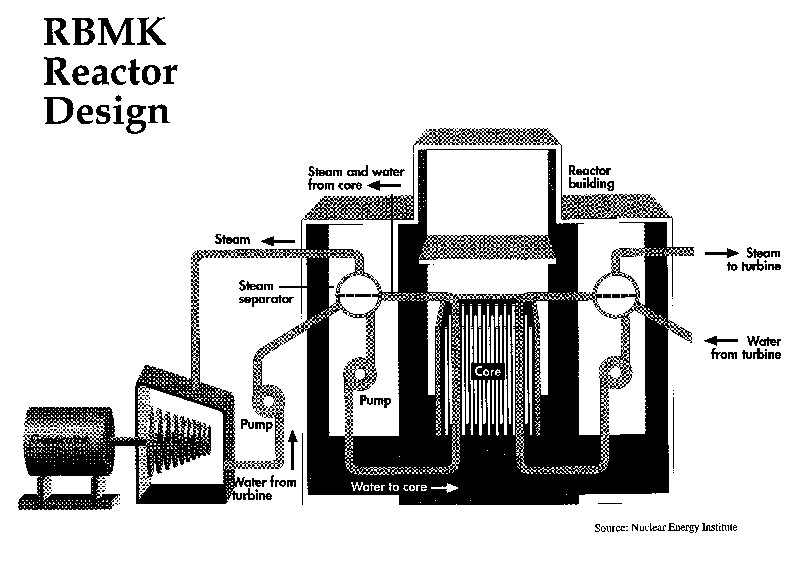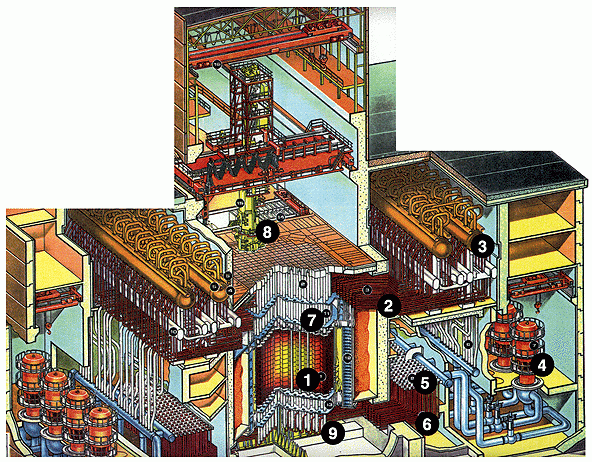
RBMK Reactor
The RBMK is unique in that it has a graphite moderator with fuel tubes and coolant tubes passing vertically through the graphite. The coolant tubes (~ 1600) carry water at 1000 psi pressure. As with the CANDU design, these reactors can be refueled on-line.

Graphic courtesy Nuclear Energy Institute
The RBMK reactor has a huge graphite block structure as the Moderator that slows down the neutrons produced by fission. Passing through the Reactor Core are 1661 vertical tubes of about 3.5 inch diameter that circulate water as the Coolant to remove the heat produced by 2 sets of long Fuel Assemblies (consisting of 18 rods lengthwise), which are also mounted in the vertical tubes. Fuel rods are about 1/2-inch diameter. The total core length is 21+ feet high. The graphite structure is contained in a steel vessel (approximate diameter of 42 feet). A helium-nitrogen mixture is used to improve heat transfer from the graphite to the coolant channels and reduce likelihood of graphite oxidation. There are 2 horizontal steam generators and 2 reactor cooling loops, with headers that then feed the pressure tubes in the reactor.
In the RBMK design, boiling occurs. The steam produced passes to the Steam Separator which separates water from the steam. The steam then passes to the Turbine as in the Boiling Water Reactor design. Similar to the BWR case, the steam is radioactive, however, the steam separator introduces a delay time so radiation levels near the turbine may not be as high as in the BWR case.
The Nuclear Energy Institute has prepared an excellent Sourcebook on Russian Design Reactors that provides extensive information on the reactor design and particulars on each RBMK station in Russia and the eastern European countries of Lithuania and Ukraine. Some of the more significant strengths and weaknesses of the RBMK design noted in the Sourcebook are:
Strength |
Weakness |
| The low core power density of RBMKs provides a unique ability to withstand station blackout and loss of power events of up to an hour with no expected core damage. | Lack of a massive steel and concrete containment structure as the final barrier against large releases of radiation in an accident |
| Ability to be refueled while operating, permitting a high level of availability | Power increases when cooling water is lost, i.e. positive void coefficient. |
| The graphite moderator design allows the use of fuel that is not suitable for use in conventional water-moderated reactors. | Accident mitigation systems are limited. |
| Flawed separation and redundancy of electrical and safety systems. | |
| Limited capability for steam suppression in the graphite stack |
The Uranium Institute sketch below illustrates the arrangement of the graphite, fuel, water pressure tube design with the arrangement of the control rods.

Graphic courtesy World Nuclear Association
For additional information on RBMK design, please go to the World Nuclear Association discussion.
Putting all the information summarized together, the following Argonne National Laboratory diagram illustrates the RBMK design in a more integrated manner and shows the major components numbered as follows:

Courtesy Argonne National Laboratory.
The Ignalina plant, one of the latest RBMK reactors built has provided summary information about each of the following areas:
The International Atomic Energy Agency has sponsored a number of technical reports about RBMK plant safety. Bulletin 381 addresses the RBMK safety program.
The Pacific Northwest National Laboratory has prepared a number of reports summarizing RBMK safety and the role the Lab has played over the past 4 years. Key pages to check are - INSP Publication Index, Nuclear Safety in Ukraine and Russia (1996), Improving the Safety of Soviet-Designed Nuclear Power Plants - Status Report (Dec. 1997), Accident Assessment for Chornobyl Reactor Unit 3 from Potential Collapse of Adjacent Building Structures - Overview and Preliminary Conclusions (Feb.1997).
Copyright © 1996-2005. Joseph Gonyeau, P.E.. The Virtual Nuclear Tourist. All rights reserved. Revised: March 15, 2001